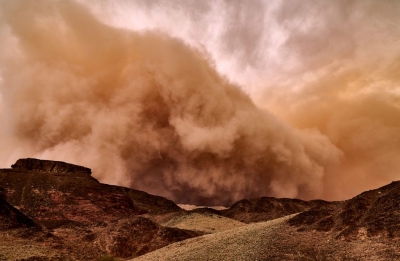
|
When strong winds storm across sandy deserts, they lift huge amounts of sand into the air and blow it about forcefully in what is called a sandstorm. The force and speed of the wind can carry the sand for thousands of kilometres before depositing it again. The coarseness of the particles can make a sandstorm really devastating. Smaller grains can remain suspended in the air for a long time. |
A sandstorm is described as a natural phenomenon that occurs when a strong wind, such as a gust front, blows fine sand particles and dust from a dry surface. These particles become suspended in the air, causing erosion where they initially were. The wind drops these particles in another place where silt is formed.
Also known as a dust storm, a sandstorm is common in arid and semi-arid regions. The primary terrestrial sources of airborne dust include the drylands around the Arabian Peninsula and North Africa. The Takla Makan and Gobi desert of China, and the Sahara desert also experience sandstorms.
A sandstorm is usually confined to the lowest ten feet. It rarely rises to more than fifty feet above the ground. The sand particles which are picked up by the sandstorm are larger than dust particles. They usually fall out of the storm more rapidly, causing it to launch not far from where the sand was initially at.
It is thought that the particles also fall to the ocean, significantly affecting the marine ecosystem. It is worth noting that the frequency of sandstorms has been increasing, albeit a well-known meteorological phenomenon since the ancient times. It has raised several health and environmental concerns due to the gravity of its surge.
Credit: Earth Eclipse
Picture Credit: Google




